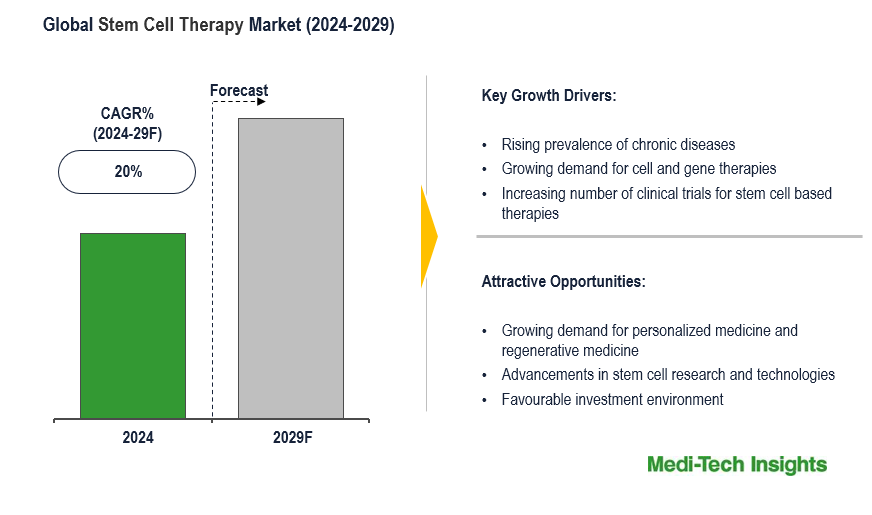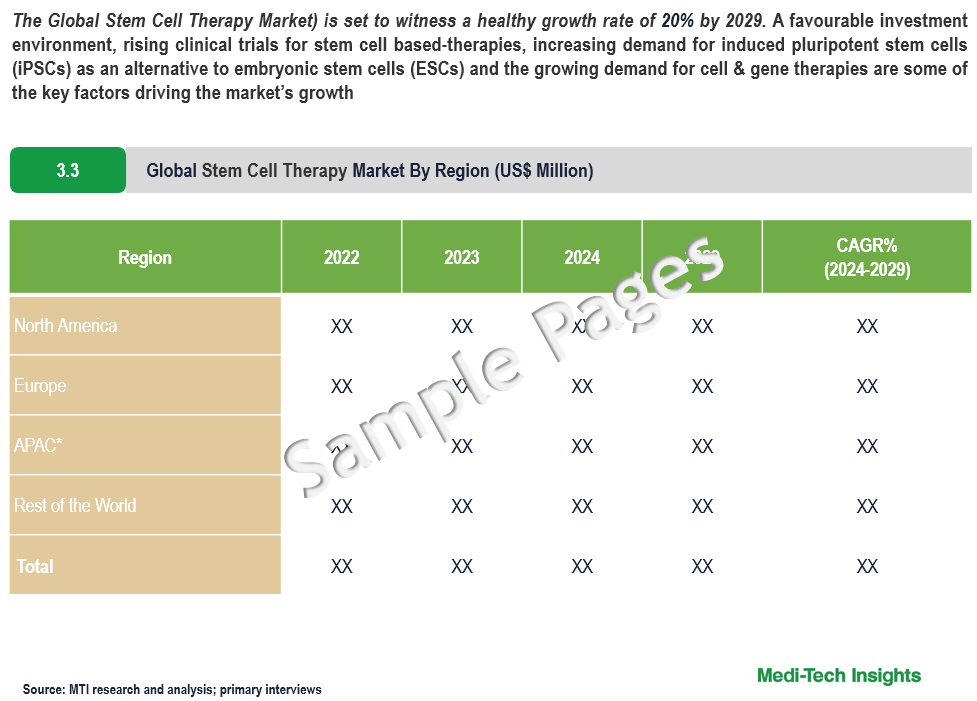
Global Stem Cell Therapy Market Size, Share, Analysis, Industry Growth, Trends & Forecasts 2024 to 2029
The Global Stem Cell Therapy Market is set to witness a healthy growth rate of 20% by 2029. A favorable investment environment, rising clinical trials for stem cell based-therapies, increasing demand for induced pluripotent stem cells (iPSCs) as an alternative to embryonic stem cells (ESCs) and the growing demand for cell & gene therapies are some of the key factors driving the market’s growth.
Derivation of embryonic stem cells (ESCs) requires the destruction of human embryos. Ethical concerns related to embryonic stem cells are one the of key factors that are likely to hamper the growth of the stem cell therapy market. A growing number of clinics offering unproven stem cell-based treatments is another ethical issue faced in the field of stem cell-based therapies. To learn more about the research report, download a sample report.
Stem cells are the body's raw materials. They are unspecialized cells that can renew themselves through mitotic cell division and differentiate into a diverse range of specialized cell types. They are critical for the development, growth, maintenance and repair of bones, muscles, blood, brain, nerves, skin and other organs. There are several sources of stem cells:
- Embryonic Stem Cells: These stem cells come from embryos that are three to five days old. These are pluripotent stem cells and can be used to regenerate or repair diseased tissues and organs
- Adult Stem Cells: These stem cells are found in most adult tissues (bone marrow or fat) in small numbers. Compared to embryonic stem cells, they have a more limited ability to give rise to various cells of the body
- Induced Pluripotent Stem Cells: Using genetic reprogramming, adult cells are transformed by scientists into stem cells that act similarly to embryonic stem cells
- Perinatal Stem Cells: These stem cells are found in amniotic fluid & umbilical cord blood. They can change into specialized cells.
Factors Igniting Interest in Stem Cells
- Prevalence of Chronic Diseases: The rising prevalence of chronic and debilitating diseases, such as Alzheimer's, Parkinson's, diabetes, and cardiovascular diseases, especially in aging populations, drives the interest in stem cell therapies. These therapies provide the potential to regenerate and repair damaged tissues
- To Develop Understanding of How Diseases Occur: By observing how stem cells mature into cells in nerves, bones, heart muscles and other organs and tissues, researchers and healthcare professionals may better understand how diseases and conditions develop
- Help in Generating Healthy Cells to Replace Diseased Cells: Stem cells possess the potential to transform into specific cells that can be used to regenerate and repair diseased or damaged tissues
- To Test the Safety and Effectiveness of New Drugs: Before using investigational drugs on people, researchers can use stem cells to test drugs for quality & safety
- Growing Awareness and Demand for Personalized Medicine: The increasing demand for personalized and regenerative medicine, coupled with the growing awareness and acceptance of stem cell therapies among healthcare professionals and the general public, is a key factor driving the stem cell therapy market. Patients are seeking more tailored and effective treatments, and stem cell therapies offer the promise of a personalized approach to healthcare, further propelling the market's expansion
To learn more about this report, download the PDF brochure
Transplantation of Blood Stem Cells Most Established Stem Cell Treatment
Currently, there are only limited stem cell therapies that have been thoroughly established as safe and effective treatments. The most well-established and widely used stem cell treatment is the transplantation of blood stem cells to treat diseases and conditions of the blood and immune system, or to restore the blood system after treatments for specific cancers.
Other areas/indications where stem cell therapies are being used are:
- For the treatment of knee cartilage defects in patients with Osteoarthritis (OA)
- For the treatment of Crohn’s fistula
- For regeneration of subcutaneous adipose tissue
- For the treatment of ALS (Amyotrophic Lateral Sclerosis)
- For the treatment of acute graft versus host disease (aGVHD) in children and adults
- For the treatment of limbal stem cell deficiency (LSCD)
- For the treatment of Critical Limb Ischemia (CLI), among others
“Stem cells have a bright future for the therapeutic world by promising stem cell therapy. We hope to see a new horizon of therapeutics in the form of bone marrow transplant, skin replacement, organ development, and replacement of lost tissue such as hairs, tooth, retina and cochlear cells.”
- CEO, South Korea Based Stem Cell Therapy Provider
Future Outlook
Stem cell therapy could be the medical innovation of the century. It has emerged as a promising new approach in almost every medicine speciality. Despite an enormous amount of research being undertaken, there are still limited safe and effective treatments available to patients. This is partially because complex diseases which are currently incurable require complex treatments and a personalised approach.
However, the prospects of stem cell therapy look promising as there are several ongoing and completed clinical trials involving stem cells which are showcasing positive outcomes.
In clinical studies and treatment attempts, stem cell therapies have been tested with the following indications:
- Macular Degeneration
- Neurological Conditions
- Diabetes
- Graft-versus-host disease (GvHD)
- Spinal Cord Injury
- Myocardial Infarction
- Autoimmune Diseases
- Autism
- Hearing Loss
- HIV
- Cirrhosis of the Liver, among others
Stem cell therapies are increasingly being seen as the transformative step in treating conditions with unmet needs. This, coupled with growing investment in the sector and an increasing number of stem cell donors is expected to drive the market forward in the coming years.
Key Challenges / Restraints: Stem Cell Therapy Market
The global stem cell therapy market faces several significant restraints. Ethical concerns surrounding the use of embryonic stem cells, which require the destruction of human embryos, pose a major challenge. Additionally, the market is hindered by the limited number of stem cell therapies that have been proven safe and effective. The proliferation of clinics offering unproven and potentially unsafe stem cell-based treatments further complicates the landscape. Moreover, developing treatments for complex diseases often necessitates personalized approaches, adding to the complexity and difficulty of creating universally effective therapies. These factors collectively impede the rapid advancement and widespread adoption of stem cell therapies.
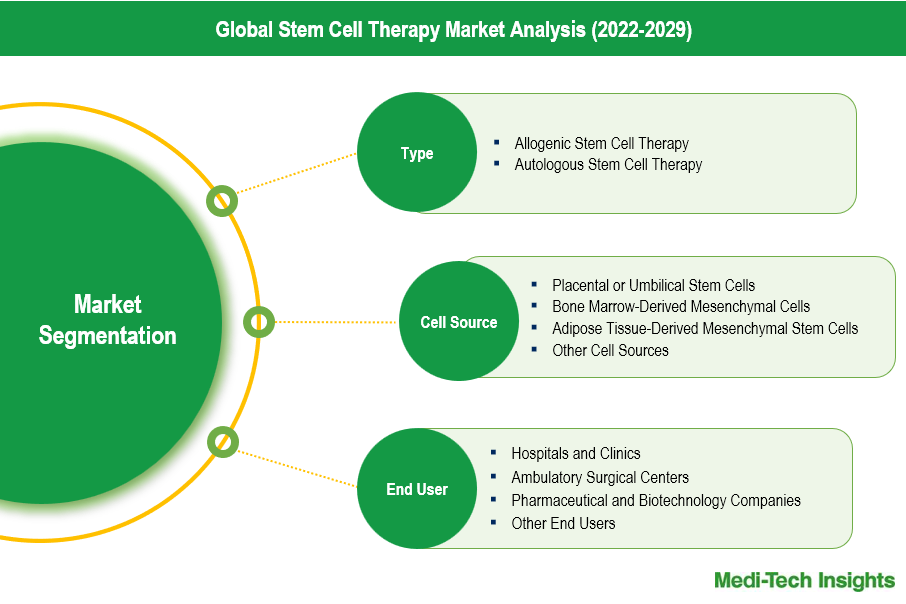
To learn more about this report, download the PDF brochure
Comprehensive overview of the Stem Cell Therapy Market by Type Segment
The global stem cell therapy market by type is segmented into allogenic and autologous stem cell therapies. Allogenic stem cell therapy, which uses stem cells from a donor, holds a significant portion of the market. This type of therapy is often preferred due to its potential to treat a wide range of conditions and its availability for patients who may not have suitable autologous (self-derived) stem cells. On the other hand, autologous stem cell therapy, which utilizes the patient's stem cells, also commands a substantial share of the market. This therapy is highly favoured for its reduced risk of immune rejection and complications, making it an attractive option for personalized treatments. Both segments are witnessing growth, driven by advancements in stem cell research, increasing clinical trials, and rising demand for effective regenerative therapies.
Comprehensive overview of the Stem Cell Therapy Market by Cell Sources Segment
The global stem cell therapy market is segmented by cell source into placental or umbilical stem cells, bone marrow-derived mesenchymal cells, and adipose tissue-derived mesenchymal stem cells. Placental or umbilical stem cells capture a notable share of the market due to their high proliferation capacity and lesser ethical concerns compared to embryonic stem cells. Bone marrow-derived mesenchymal cells hold a significant market share, largely because of their established efficacy in treating various blood and immune system disorders, as well as their extensive use in clinical applications. Adipose tissue-derived mesenchymal stem cells also command a substantial portion of the market. They are valued for their ease of extraction, abundance, and potential in regenerative medicine applications. Each of these subsegments is driving market growth through continuous research, expanding clinical trials, and increasing therapeutic applications.
Competitive Landscape Analysis: Stem Cell Therapy Market
Some of the key players operating in the market are JCR Pharmaceuticals, MEDIPOST, Takeda Pharmaceutical Company, PHARMICELL, Smith & Nephew, AlloSource, Anterogen Co., Ltd., NuVasive, Inc., RTI Surgical, Inc., Holostem Terapie Avanzate S.r.l, Regrow Biosciences, CORESTEM, and Stempeutics Research, among others.
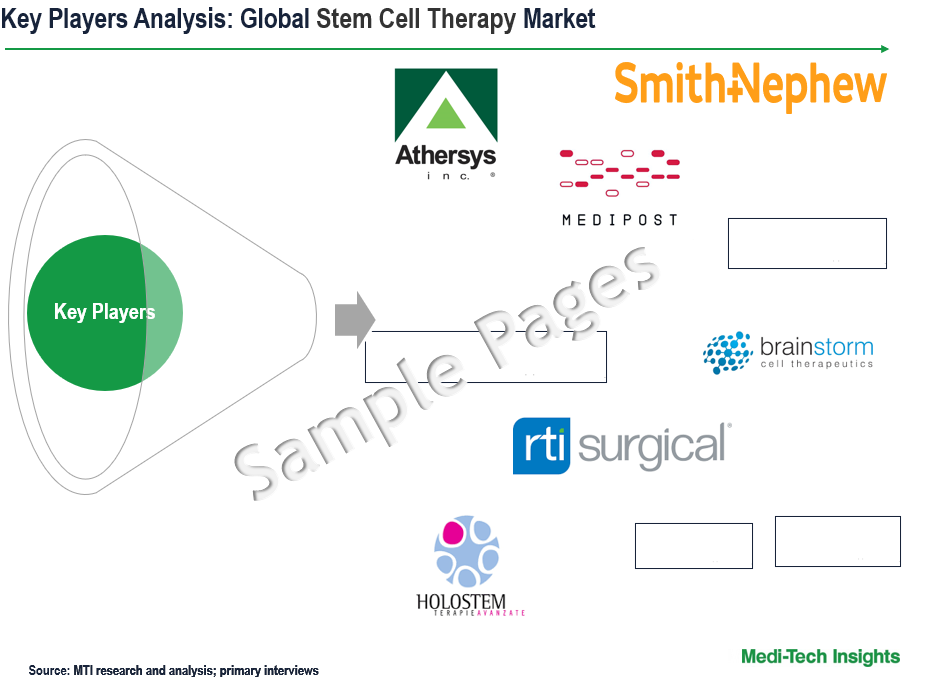
Get a sample report for competitive landscape analysis
Organic and Inorganic Growth Strategies Adopted by the Leading Market Players to Establish Their Foothold in the Global Stem Cell Therapy Market
Leading players operating in the global market are adopting both organic and inorganic growth strategies such as launching new services, acquiring related firms, and entering into collaborations to garner a higher market share.
For instance,
- In January 2024, Smith+Nephew announced the completion of its acquisition of CartiHeal, the developer of Agili-C, a novel cartilage regeneration technology for sports medicine knee repair
- In January 2024, RTI Surgical, announced the completion of its acquisition of Cook Biotech Incorporated, enhancing its CDMO capabilities and expanding its portfolio of allograft and xenograft biomaterials
- In October 2022, Sysmex Corporation and JCR Pharmaceuticals Co., Ltd. announced the establishment of a joint venture for the research, development, manufacture, and sale of cell-based regenerative medicine products, including hematopoietic and other stem cells
- In July 2022, Vertex Pharmaceuticals Incorporated announced a definitive agreement to acquire ViaCyte, a privately held biotechnology company specializing in stem cell-derived cell replacement therapies aimed at curing type 1 diabetes (T1D), for $320 million
- In May 2022, Medipost secured a foothold in North America by announcing an investment of CAD 90 million (KRW 88.6 billion) in OmniaBio, a Canadian contract development and manufacturing company (CDMO) for cell and gene therapy products
- In July 2021, Minovia Therapeutics, Ltd. and Astellas Pharma Inc. announced a worldwide strategic collaboration and license agreement for the research, development, and commercialization of novel cell therapy programs targeting diseases caused by mitochondrial dysfunction
Global Stem Cell Therapy Market is expected to gain further momentum in the upcoming years due to growing demand for cell & gene therapy and personalized medicine, rising number of clinical trials, stringent regulatory policies and aggressive organic and inorganic growth strategies followed by the key market players.
Stem Cell Therapy Market Scope
| Report Scope | Details |
| Base Year Considered | 2023 |
| Historical Data | 2022 - 2023 |
| Forecast Period | 2024 - 2029 |
| CAGR (2024-2029) | 20% |
| Segment Scope | Type, Cell Sources, Therapeutic Applications and End User |
| Regional Scope |
|
| Key Companies Mapped | JCR Pharmaceuticals, MEDIPOST, Takeda Pharmaceutical Company, PHARMICELL, Smith & Nephew, AlloSource, Anterogen Co., Ltd., NuVasive, Inc., RTI Surgical, Inc., Holostem Terapie Avanzate S.r.l, Regrow Biosciences, CORESTEM, and Stempeutics Research among others |
| Report Highlights | Market Size & Forecast, Growth Drivers & Restraints, Trends, Competitive Analysis |
Key Strategic Questions Addressed
-
What is the market size & forecast for the Global Stem Cell Therapy Market?
-
What are the historical, present, and forecasted market shares and growth rates of various segments and sub-segments of the Global Stem Cell Therapy Market?
-
How has COVID-19 impacted the Global Stem Cell Therapy Market?
-
What are the major growth drivers, restraints/challenges impacting the market?
-
What are the opportunities prevailing in the market?
-
What is the investment landscape?
-
Which region has the highest share in the global market? Which region is expected to witness the highest growth rate in the next 5 years?
-
Who are the major players operating in the market? What is the competitive positioning of key players?
-
Who are the new players entering the market?
-
What are the key strategies adopted by players?
The study has been compiled based on extensive primary and secondary research.
Secondary Research (Indicative List)

Primary Research
To validate research findings (market size & forecasts, market segmentation, market dynamics, competitive landscape, key industry trends, etc.), extensive primary interviews were conducted with both supply and demand-side stakeholders.
Supply Side Stakeholders:
- Senior Management Level: CEOs, Presidents, Vice-Presidents, Directors, Chief Technology Officers, Chief Commercial Officers
- Mid-Management Level: Product Managers, Sales Managers, Brand Managers, Business Development Managers, Consultants
Demand Side Stakeholders:
- Stakeholders in Academic & Research Institutes, Pharmaceutical & Biotechnology Companies, Clinical Laboratories, Hospitals, Ambulatory Surgical Centers and Other End Users
Breakdown of Primary Interviews
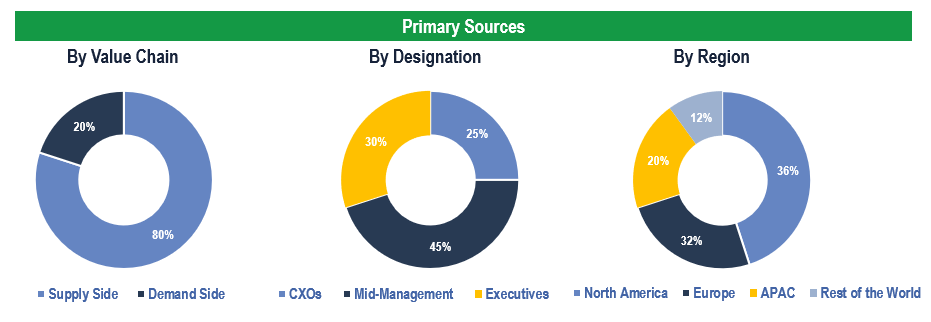
Market Size Estimation
Both ‘Top-Down and Bottom-Up Approaches’ were used to derive market size estimates and forecasts.
Data Triangulation
Research findings derived through secondary sources & internal analysis were validated with Primary Interviews, Internal Knowledge Repository, and Company Sales Data.

